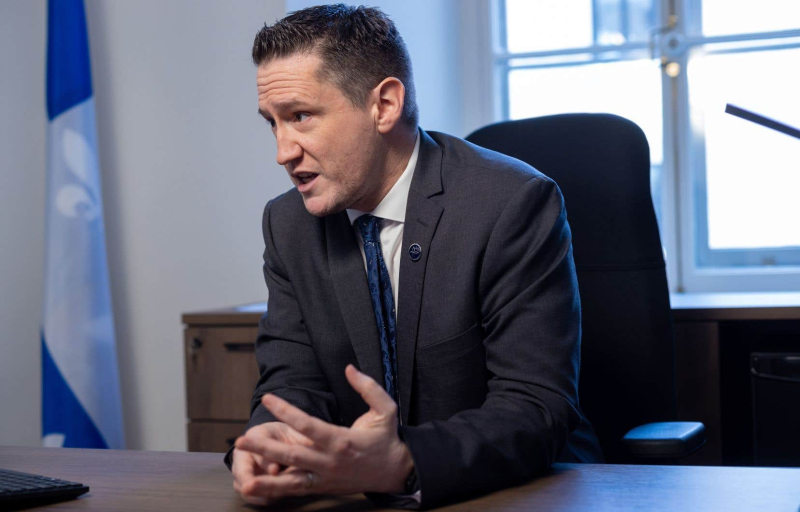
Photo: Francis Vachon Archives Le Devoir The Minister of the Environment, the Fight against Climate Change, Wildlife and Parks, Benoit Charette (seen here in January 2023), is scheduled to meet next Wednesday with the chief of the Kebaowek community band council , Lance Haymond, one of the most vocal opponents against the Ontario nuclear dump.
François Carabin
January 23, 2024
- Quebec
Quebec Minister of the Environment, Benoit Charette, will wait to meet with the Anishinaabe community of Kebaowek to take a position on the Chalk River nuclear dump project. His office has scheduled a meeting with the First Nation next week to discuss this hotly contested initiative.
So what does the Quebec government have to do with a proposed Ontario nuclear waste landfill ? The answer lies partly in the significant opposition it encountered in Quebec, in the cities — Gatineau, Montreal and the municipalities of the Metropolitan Community — and among the First Nations.
At the beginning of January, the Canadian Nuclear Safety Commission (CNSC) granted Canadian Nuclear Laboratories (CNL) the necessary authorization to erect “a near-surface waste management facility” on the Chalk River Laboratories site in Ontario. The project, located very close to the Ottawa River, on the unceded traditional territory of the Anishinaabe First Nation, worries more than one in Quebec.
The indigenous community of Kebaowek, which is located in Quebec, very close to the Ontario border, believes that the establishment of such a dump could have irreversible repercussions on biodiversity and the territory. According to the Metropolitan Community of Montreal and the City of Gatineau, it would put the quality of drinking water downstream of the Ottawa River at risk. Environmental groups are also among the main opponents of the project.
However, before Le Devoir asked him for his opinion on the project, the government of François Legault had still not taken a position on this subject. Québec solidaire also criticized him for this in a press release on Sunday. “The opposition to the Chalk River nuclear dump project is too important for the current silence of François Legault,” supported solidarity MP Sol Zanetti.
Also read
- Anishinaabe people revolt against nuclear storage site near the Ottawa River
- At Chalk River, proof of radioactive waste storage remains to be done
- The Montreal Metropolitan Community once again opposes the Chalk River nuclear storage project
“We hear the concerns raised about the project. […] Rest assured that we are following the matter closely,” the office of the Minister of the Environment and the Fight against Climate Change indicated on Tuesday to Devoir , Wildlife and Parks.
According to our information, he is due to meet next Wednesday with the head of the Kebaowek community band council, Lance Haymond, one of the most vocal opponents against the Ontario nuclear dump. “There are other groups with whom we would like to discuss before making a formal decision,” the minister’s press secretary, Amélie Moffet, told us.
Repercussions on wildlife and the territory ?
In Kebaowek, we are counting on the support of the CAQ government in the matter. “It would be a big, big victory for Kebaowek, for the Anishinaabe nation and for the Ottawa River if we could have this support from Quebec,” said band councilor Justin Roy in an interview on Tuesday.
“We have inherent rights and titles which are protected by Article 35 of the Constitution. It is our right to ensure that our territory and everything on it is protected,” he continued.
The community of Kebaowek claims to have detected black bears, eastern wolves as well as several species of bats, turtles and birds in the area surrounding the LNC facilities.
“The more you look at the project and the endangered species, the more you realize that there would be huge impacts [to move forward],” Roy said on Tuesday.
The day before, the Assembly of First Nations of Quebec and Labrador (APNQL) had maintained in a press release that the most recent decision of the CNSC went “against the rights of indigenous peoples and environmental protection requirements”. Asked by Le Devoir, Tuesday, its leader, Ghislain Picard, did not exclude that the AFNQL would launch legal proceedings in the event that the project moved forward. “We have always insisted on public pressure, then the courts as a last resort. But sometimes, when we don't have a choice, it's the only option available to us,” he said.
The cities and municipalities of the Montreal Metropolitan Community say they are “disappointed” with the conclusions of the independent federal body. “Greater Montreal is located downstream of [Chalk River] and would suffer the consequences of possible environmental damage,” wrote the Montreal umbrella organization on the social network X on January 10.
On its website, LNC maintains that carrying out its project “provides a safe means of disposing of low-level radioactive waste.” The facility “was specially designed to isolate this waste from the environment,” it is written. “According to a very conservative estimate, the lifespan of the installation is more than 550 years, a sufficient period for the radioactivity to have decreased and its intensity [to be] equivalent to that naturally present in the environment. »
“The project […] is designed to protect human health and the environment, including the Ottawa River, and […] the proposed location is acceptable and safe,” wrote the CCSN in its decision at the beginning of January.

